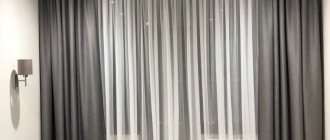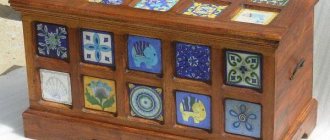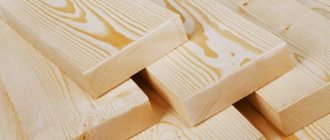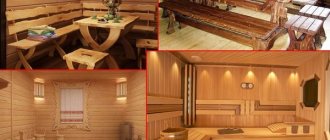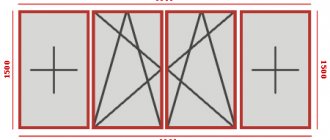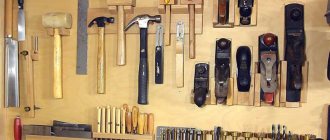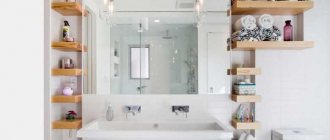Every car enthusiast dreams of a garage, which will become not only a reliable “home” for his favorite car, but also a warm, equipped workshop for work at any time of the year. Decorating the inside of a garage is one of the most pressing issues, since it should not only give a neat and cozy appearance to this room, but also correspond to the features of the structure, taking into account its operational focus.
Garage interior decoration
Today there is no shortage of finishing materials on the construction market - there is a very wide range with different characteristics and cost levels. Therefore, from this variety it is quite possible to choose an option that is suitable in all respects for finishing a garage space. To decide which finish is most suitable, it is necessary to consider the basic requirements for facing materials for such technical buildings. An important selection criterion will be what appearance the garage would like to receive as a result.
Racks and shelves in the arrangement of the garage
Racks and shelves are a great idea for keeping your garage organized. They practice installing these items against a long wall. Models made from natural wood are considered the most popular.
Rack in the garageSource materialyinfo.ru
These multi-level shelves offer storage for small metal items. In addition, stands and grilles are installed on them. They try to place work bags, containers and suitcases on the lower tiers. Typically, these shelves can withstand heavy loads and look good in a garage setup.
Functional shelving in the garageSource medium.spb.ru
Metal racks with four tiers are suitable for storing suitcases, bags, power tools and other useful accessories. Special niches may also be provided in which car tires are placed. In the middle of this design they try to place a cabinet with a door. There may be a work safe or a toolbox. If there are no shelves inside, then the space is decorated with hangers.
Shelves in the garageSource chrome-effect.ru
If the garage does not have the ability to mount shelves on the walls, then it is possible to use floor models with a metal profile frame. Approximately the width of such structures does not exceed 60 cm, and the height is 150-170 cm. The material used as the flooring itself is chipboard or USB. They are very durable and interchangeable.
Metal rack for garageSource newsbel.by
Sometimes not a lot of furniture can fit in the standard garage perimeter. For this purpose, they came up with an alternative in the form of a two-in-one metal structure. It also includes stands that are adjacent directly to the wall and can serve as a place for hanging equipment. Also in these headset models there are retractable narrow drawers. They have a high-quality working mechanism. Even under weight they do not jam and function stably.
Convenient shelves for equipmentSource www.rangementspacer.com
They try to complement large garages with panoramic windows and high-quality interior finishing with massive metal or metal-plastic cabinets on casters. Such sets are very convenient to move, arranging rearrangements. The open shelves are a steel frame with a lattice platform for each tier. Due to the perforation of the racks, the structure gains strength and stability.
Materials
There are many materials that can be used to decorate a garage. Sheathing can be done with corrugated sheets, clapboard, plasterboard, or stone. To determine which one is best suited, it is necessary to consider them in more detail.
Concrete
Concrete is most often used for such premises. After all, it holds up better than others on walls made of brick or aerated concrete. It has great strength, is not afraid of fire, and if necessary, repair work can be easily carried out on a concrete surface.
But like any material, concrete has disadvantages. Its installation is a labor-intensive job that involves preparing the solution as well as applying it. It is necessary to have certain skills in finishing work. Their absence can lead to cracking of the surface or even spalling of the concrete. The second disadvantage is that this process is considered a dirty job, so there will be a lot of cleanup at the end, which not everyone wants to deal with.
Drywall
The interior decoration of a garage can be done using plasterboard. To attach it, you can use special glue. If the surfaces have uneven surfaces or the room needs to be insulated, you can attach it using a metal frame. However, this option will take up some space and the room will decrease in size. For a garage, it is better to take fire-resistant and moisture-resistant plasterboard, which has a gray-green color and red markings.
GKLVO has many advantages. These include relatively low weight, ease of installation work, and low price. Compared to other materials, the room remains clean while finishing with sheets, and upon completion there is no need to spend a lot of time cleaning. The material also absorbs moisture well. If necessary, you can make partitions from it, mounted using an iron frame, and organize a workshop or small warehouse.
Ceramic tile
This material is ideal for the garage. After all, high-quality tiles are water-resistant and fire-resistant. It makes the room neat due to the fact that it can be washed using any means and is cleaned in just a couple of minutes.
If the tiles are laid correctly, they will withstand any load and will last a long time.
Panels
Covering a room with clapboard is very popular. It may consist of natural wood. Surfaces can also be finished using PVC panels or OSB sheets. This material is easy to install. If we consider wooden panels, they also have many advantages. Advantages include long service life, frost resistance, environmental friendliness, and a large selection of colors.
However, it cannot be done without drawbacks. Wooden panels are susceptible to insect attacks, are highly flammable and susceptible to mold, and are also expensive.
The advantages of plastic panels include such qualities as light weight, the ability to withstand temperature changes, and the ability to carry out installation work with your own hands without the involvement of specialists. Also, such panels have a low price and a large selection of colors.
The disadvantages are that they are fire hazardous and very fragile.
OSB
OSB sheets consist of layers of wood shavings, which are large in size. Tree resins from pine needles or formaldehyde are used for binding.
Sheets are divided into several types. OSB-3 is of high quality and has high moisture resistance. However, OSB-4 is considered more durable, and it can also be used for interior and exterior decoration. It is not afraid of temperature changes, has a long service life, and good sound insulation. However, it is also highly flammable.
Modular covering
A completely new type of finishing material is slabs consisting of PVC or rubber. They can be laid not only in the garage, but also on the area adjacent to it.
Modular slabs have many positive reviews. They can withstand any, even very low temperatures, are easy to install, and have high strength. Installation is carried out using special glue.
Siding
Most often, this material is used to decorate the exterior of a brick room. Covering with siding gives even an old building beauty and attractiveness. However, recently it has begun to be used for interior decoration of garages, because it has many advantages.
First of all, I am glad that it is fireproof, durable and relatively inexpensive.
Stone
Natural or artificial stone is often used for cladding garages. This finish looks very beautiful, and is not afraid of weather conditions, humidity, or fire. However, its price is too high.
No. 1. Plaster
This is one of the most budget-friendly, and therefore most popular, ways to decorate a garage space. This cladding method is almost ideal for the requirements described above. The list of advantages is significant:
- relatively low cost, which is what you need for a garage;
- the ability to level and hide minor imperfections in the base, so preparatory work is greatly simplified;
- plaster does not take up useful space, unlike finishing that must be mounted on the frame, for example, drywall;
- wear resistance, strength, relative resistance to mechanical damage;
- fire and mold resistance;
- resistance to temperature changes, moisture resistance;
- durability;
- application speed;
- simple but nice appearance.
No matter how much one would like to, it is still impossible to call plaster an ideal coating for finishing garage walls, and the following disadvantages are to blame:
- complexity of application and “dirty” installation process. You should only undertake finishing work yourself if you are 110% confident in your own preparation. Otherwise, it is better to entrust the work to specialists. If mistakes are made during installation of the plaster, then in the first winter, due to temperature changes, cracks will appear on the surface, and some areas will begin to peel off;
- The surface of the plaster gets dirty quickly, and it can be difficult to wash off the dirt. But this drawback can be easily eliminated. After applying a layer of plaster and drying it, the surface is treated with facade paint, which provides additional resistance to moisture, dirt-repellent properties and simplifies maintenance. You can choose any color, thus also solving the issue of the aesthetic side of the cladding.
Plaster can be applied to almost any base, but it will adhere most strongly to walls made of brick, as well as aerated concrete and other concrete blocks. For work, it is better to take a cement-sand based composition.
Floor treatment instructions
So, all the materials have been purchased and you are ready to go.
Attention! If water constantly accumulates in the garage, slope the floors slightly. The floor pouring process consists of the following steps:
The floor pouring process consists of the following steps:
- Making a sand pillow. It is necessary to fill the crushed stone to a height of several centimeters. Then - a layer of sand a few centimeters deep. Fill with water and level. Wait until the mixture is completely dry.
- Waterproof the garage walls. Polyethylene works well. 10 centimeters should be enough.
- Reinforcement. Necessary to increase the strength of concrete. To do this, a wire mesh is made. The cell size is about 10 centimeters. Bricks are suitable as fasteners. The guideline for installation will be iron pipes or wooden boards. Using formwork, install gaps from boards and fill them with insulation. This operation is necessary to ensure that the floor is very durable and does not freeze in winter.
- Now you can lay the concrete. Mix a solution of cement, water and sand in a container. When styling, use a vibrator to remove air from the mixture. Level it using the rule.
- Now you need to wait until the concrete dries. Cover it with film and water it with water. This will allow it to retain moisture. The structure will become completely durable in a month.
- Powder coat your garage.
Attention! This type of work is recommended to be done in summer
Preparatory work
First of all, you need to make a sheathing frame. Almost all types of finishing panels are mounted on it using a single simple technology. It is made from wooden beams or metal profiles. The easiest way to install an aluminum profile. To avoid rotting or other damage, the wood is treated with an antiseptic. Next, insulation is laid into the cavity of the frame - better tile than roll. It is usually attached to an adhesive base or with self-tapping screws with a wide head.
The distance between the sheathing beams is made slightly smaller than the width of the insulation, which is laid under the frame.
You cannot use polystyrene foam for insulation (due to flammability); mineral wool and expanded polystyrene are better suited.
Foil or polyethylene is glued to the insulation to prevent moisture from collecting. Now you can veneer.
It is easy to install not only insulation under the sheathing, but also to place cables, pipes, and ventilation.
All finishing materials, except metal, are attached to the sheathing not rigidly, but with a small gap. Then the cladding will not suffer from temperature fluctuations.
As a base, concrete is considered the best: cheap, durable, safe. However, it absorbs everything and generates a lot of dust. Therefore, it needs to be refined with something on top. The simplest option is paint or impregnation, but they do not last long. It is more reliable to pour polymer floors: they are suitable in all respects and if you follow the technology when pouring, they will last for decades. It is easy to lay tiles on concrete, but before finishing the inside of the garage in this way, you should first treat it with a primer so that the glue does not absorb. The best are clinker tiles (expensive) or porcelain tiles (equally durable, but much cheaper).
A functional and safe coating is provided by rubber, rolled or in the form of tiles.
How to plaster walls and ceilings with your own hands
Plaster work starts from the ceiling and ends with the walls.
- First, carefully evaluate the surface of the walls and ceiling. Remove all protruding parts and cover the depressions with cement-sand mortar over a previously wetted surface.
- The ceiling is most often made of reinforced concrete slabs. If you are not striving for an ideal surface, installing beacons is not necessary, and the joint can be leveled using mortar. The ceiling is plastered with lime, cement and gypsum mortars. Despite the fact that gypsum lays down better and sets faster, they cannot withstand temperature changes. Therefore, in unheated rooms it is recommended to plaster with cement mortar in a ratio of cement and sand of 1:3 or 1:4.
- After cleaning the surface, a primer is applied for better adhesion.
- After the primer has dried, the plaster is applied with a spatula or trowel in several layers. Each layer should be 0.5–1 cm, and the next one is applied after the previous one has set. In this case, the total thickness of the plaster should not exceed 1.5 cm, sometimes 3 cm. The first layer is the base layer, which should adhere well to the concrete. The second layer is leveling. The third is finishing, troweling, applied in a circular motion.
- Wall plaster is also applied in 2–4 layers along the beacons. The recommended layer thickness is 3 cm. Beacons set the thickness of the plaster layer. They use metal slats or strips of mortar, aligned with the rule. All beacons are finally adjusted by level. Metal ones are attached to dowels or mortar, and after plastering they are dismantled.
- Clean the surface from dust and debris, moisten the wall with a roller or spray, or coat it with a primer.
- First, the first layer is applied to the wall - spray, which provides adhesion to the surface. After the spray dries, there is a thicker base layer - soil, which is used to level the surface. The plaster is finally rubbed with a covering layer.
- Apply putty in 1-2 layers with a thin spatula to level the surface.
- The primer is applied with wide brushes and a roller. Be sure to let it dry before applying the next coat.
- Painting is done with a roller and brushes in 2 layers.
Flooring and flooring
A good floor covering is an important stage in arranging a garage. The garage floor must have a number of properties:
- strength;
- do not give severe cracks;
- ease of care, removal of oil stains;
- not slippery;
- safe, non-flammable;
- ease of dust removal (an eternally dusty concrete floor is not the best solution).
Modern floors are durable, easy to use, easy to clean, resistant to chemicals, mechanical and abrasive substances.
Ceramic tiles, terracotta
Terracotta and ceramic tile surfaces are an excellent solution, the tiles are easy to clean, and the rough surface will prevent slipping. The disadvantage of tiles is that regular cleaning of the joints between the tiles is too troublesome.
Vinyl floors
Today's compact vinyl flooring panels are made from durable, technologically advanced plastics. The panels have a number of advantages:
- not slippery;
- resistant to gasoline, oils, acids, chemicals;
- easy to clean;
- antibacterial, protected from mold;
- high speed of assembly and disassembly without the use of adhesives, solutions, or tools.
Epoxy floors
Epoxy floors are very practical:
- resistant to abrasion and scratches;
- resistant to loads and impacts due to the properties of the material (epoxy resins doped with colored quartz);
- Easy to keep clean, no welds.
Epoxy floors are effective. There are varieties that are homogeneous or similar to granite.
Video description
About the intricacies of self-leveling floor in the following video:
The flooring in the garage has special requirements; it must withstand significant and regular weight loads from the car. The preferred flooring options are:
- Painted concrete floor. A popular option that can easily withstand the weight of a car. A concrete floor coated with a primer weakly absorbs spilled auto chemicals, does not collect dust and is resistant to abrasion. Although the process of installing a concrete floor cannot be called quick, many car enthusiasts opt for it due to the low costs and simplicity of the technology.
- Tile. A garage floor made of ceramic tiles (or ceramic tiles) looks neat and often original. The coating is advantageous due to its durability, easy maintenance and resistance to fuels and lubricants. The limiter to the use of tiles is their high cost and the rather labor-intensive process of creating a tile covering (including mandatory waterproofing).
Ceramic tile flooringSource koon.ru
- Poured concrete. Impact-resistant coating with a perfectly flat surface, not inferior in strength to a classic concrete floor. One of the most successful coatings for a garage, as it is frost-resistant and has increased resistance to chemical environments. The disadvantage of this method is the high price of the composition, which is why self-leveling flooring cannot be called an economical option. Another subtlety is that the base for pouring must be perfectly flat, which is not always achievable.
- Wooden floor. The choice in favor of a wooden floor covering (from floorboards) is not often made, although the base for such a floor does not need to be leveled. Many believe that this type of floor has more disadvantages than advantages - flammability, high degree of absorption and low strength. Proponents claim that wood flooring is much more pleasant and healthier to work on; In addition, wood (unlike concrete) does not generate dust.
Self-leveling polymer flooringSource ko.decorexpro.com
How and with what to cover the inside of a garage inexpensively? Selection of materials
Even at the project stage, the owners think through the aesthetic and functional decoration of the garage walls.
There are construction options in which interior decoration is not required at all (for example, neat brickwork of walls).
But such common wall materials as cinder blocks, foam blocks, sawn limestone or shell rock are initially intended for subsequent finishing.
Built into a basement made of large foundation blocks, the garage resembles a concrete cave; you just want to hide the walls behind the cladding.
The problem of finishing interior walls also arises when purchasing an old garage on the secondary real estate market. Therefore, the question arises: How to decorate the inside of a garage cheaply?
No. 8. Concrete
The most affordable option for finishing garage walls is to use concrete. True, provided that concrete was also chosen for the floor covering, you will end up with a not very attractive gray box, but the arrangement will not cost a pretty penny, everything will be reliable and durable.
Advantages:
Minuses:
Floor construction
Very often people need a garage only to store their car, and therefore the presence of an inspection hole is not necessary. Then, when laying the floor, you can simply make a screed. This is not a very complicated process, and anyone can do everything with their own hands.
To do this, the first step is to level the ground with sand and crushed stone. Then a layer of waterproofing layer is laid down. Roofing material is suitable for these purposes. It must be overlapped so that the moisture of the concrete solution cannot escape into the ground. You can put a reinforcing mesh on top of the roofing material for a stronger screed.
The next step is the installation of beacons, which is done according to the level. This will make the flooring even. Then a concrete solution is prepared and poured onto the floor. Its components are very simple and widely available. This is ordinary sand, cement and crushed stone, the proportions of which are 2: 1: 3, respectively. Everything is filled with water to create a solution of medium thickness. To make the work easier, you can use a concrete mixer.
Filling must be done in one step so that the floor does not have cracks and is solid. The screed must be at least ten centimeters thick. Upon completion, you need to level the surface well using a building level. The drying process can last up to one month.
After this time, you can begin finishing the concrete. Moisture-resistant paint or marble chips are suitable for this. The ideal coating would be ceramic, paving or clinker tiles that can withstand any load. Before laying it, it is necessary to treat the concrete surface with a primer that does not allow it to absorb moisture from the adhesive, and only then begin laying the tiles.
If the floor requires insulation, it is necessary to make a flooring from boards. To do this, wooden logs are laid on top of the concrete. The space formed between them must be filled with expanded clay or polystyrene. If the garage has a basement or cellar, then loose insulation is poured in, and reinforcing mesh is placed on top. This is done for additional insulation of the basement ceiling.
There is also a self-leveling floor. It is a very durable coating and is in no way inferior to concrete. The main advantage is a completely flat surface. Its only drawback is its high cost. Therefore, most still prefer a concrete surface.
Stage 2. Inspection hole
Inspection hole
To repair a machine, it is advisable to equip an inspection hole. Even the most minor breakdown becomes a serious test if it is impossible to reach it without an inspection hole. In such cases, you have to go to a service station and pay a considerable amount for repairs.
In a word, the arrangement of the inspection pit will soon pay off. Below is the sequence of actions.
Step 1. First, the dimensions of the future pit are determined and markings are made. In this case, you need to maintain a balance - firstly, the pit should be spacious enough, and secondly, its width should be such that no problems arise when entering the garage.
Planning
The required width is 0.7 m; it will allow you to feel comfortable when carrying out repairs and at the same time leave enough space for parking maneuvers.
Planning
Regarding the depth, it depends on your own height, but again it is better to make it a little deeper than required - it is much easier to equip additional flooring than to redo the floor when deepening it.
Step 2. Once the marking is completed, you can begin excavation work. The most difficult thing is to dig a hole, because you will have to remove more than 9 cubic meters of soil.
Once the marking is complete, you can begin excavation work.
Step 3. The floor is leveled and covered with a 25-centimeter “cushion” of crushed stone. It is noted where the niches for the tools will be located.
Step 4. The walls can be poured with concrete or lined with brick. Concrete is more reliable, so it will be considered.
Brick wall laying
First, the floor is poured; a thickness of 7-8 cm will be quite enough. For reliability, you can pre-lay the reinforcement. Next, a wooden formwork is constructed, which will be gradually filled with mortar in tiers of 40 cm. The upper edge is reinforced with a metal structure, and lamps are installed.
Installation of formwork
Pouring concrete
Finishing the pit with tiles and installing lamps
Garage interior
The optimal design of a garage should not only be visually attractive, but also convenient for its owner. Various decor and all sorts of little things would be out of place here. To emphasize your individuality and create a pleasant environment for your stay, you can decorate the walls with posters, placards, and tool stands. Minor details should not take up much space.
After completing your garage renovation, it is important to keep it tidy. The ease of use will depend on this
In a cluttered room it will be difficult to find the things you need. To hide open shelves and racks from view, use tarpaulin screens or water-repellent curtains. To quickly sweep away debris, it is necessary to provide special holes on the shelves.
Equipment
It is worth considering the availability and need for various types of equipment.
More and more garage owners prefer to have their own car wash in their garage. Of course, this will not be a complete wash, but it will be enough to wash the car. The sinks are sold ready-made, they take up very little space and are easy to use.
To equip a garage with a sink, you only need a water supply and drainage, if this cannot be done directly to the street.
Compressor
The compressor is important. The options for using it in the garage are simply endless. Starting from simple tire inflation to cleaning tools, blowing out car parts or cleaning hard-to-reach corners of the garage from dust.
Welding machine
When choosing a welding machine, you should know in advance what it will be used for. An electronic AC machine is suitable for general welding. But it is not suitable for body work, as it can burn holes. For these purposes, a device with a tungsten electrode and a protective gas environment is required.
Water-oil separator
This device will be needed when painting work in the garage. Allows you to clear the air of water, oil and other elements that are unfavorable for painting.
Properly selected equipment can greatly simplify the life of a car enthusiast. There are quite a large number of options for equipment that can be placed in the garage. You just have to remember about the limited garage space.
A two-level garage is an excellent option for those who want to equip their garage to the highest standard.
Criteria when choosing a garage finish:
- Impact resistance;
- Easy to care for;
- Moisture resistance;
- Fire resistance;
- Strength;
- Resistant to temperature changes.
Before choosing what to decorate the walls in the garage with, you need to decide what the actual requirements of this room are? The garage is a cold and damp place. At the same time, the presence of technical dirt can ruin any type of cladding.
The material for the walls should be chosen to be impact-resistant, it is better that the surface is not afraid of scratches. We often store a lot of flammable substances in the garage, so its lining must be fire-resistant or at least flame-retardant.
Another decisive factor is ease of maintenance. Few people would want to constantly wash walls, so the material should not be susceptible to aggressive substances and not be afraid of wet cleaning.
Before cladding, garage walls are usually insulated. However, this should not be overdone. Many people think that the ideal conditions for keeping a car are the same as those for a person. Quite the opposite. The temperature in the garage in winter should not exceed five degrees. Strong temperature changes will not benefit your iron horse, but will only harm.
Another common mistake is lack of ventilation. There is no need to plug every last hole, as this will prevent the car from being ventilated and you risk getting hurt yourself. In the garage, a lot of harmful gases that are dangerous to health and life collect from the car. A ventilation system is a must.
How to insulate walls in a garage:
- Mineral wool
- Glass wool
- Styrofoam
One of the common insulation materials is mineral wool. This is a breathable material, it will not create a can effect. The weak side of cotton wool is that it absorbs moisture, so when using it you need to protect it with a vapor barrier.
Glass wool is one of the cheapest insulation materials. But working with it is much more difficult. You need to work carefully, wearing protection and gloves. You won't be able to scratch your nose while working. Glass wool is afraid of water, so it is wrapped in foil insulation for protection. If water gets on the glass wool during operation, it can be thrown away.
The most common insulation material is polystyrene foam. It is also used in apartments, houses, and garages. It's easy to work with and inexpensive. It is easy to cut and weighs little. Polyfoam is not afraid of moisture, insects, rotting, no additional processing is required. But he also has weaknesses. Polystyrene foam does not allow air to pass through and burns quite well.
Maximum heat loss occurs through the garage door, so insulating it is most important. You may not even need to insulate just the gate
Their insulation occurs in the same way as walls.
In which rooms can decorative stone be used?
Decorative stone ennobles any room, making it especially atmospheric and chic. Today, this material has begun to be boldly used for decorating children's rooms, balconies and baths. Most often it is used in the following areas:
Hallway Wall decoration. This option indicates the high status and sense of taste of the apartment owners. It is recommended to use it to decorate one or several zones, or to completely cover one of the walls. Depending on the color, you can achieve different visual effects: light visually expands the space, while dark absorbs it;
Popular stone cladding in the hallway
Living room Strengthening individual zones. A place to relax, a fireplace, a library, a TV or a stereo system - selective use allows you to create coziness and comfort in the living room, making it luxurious and modern;
Living room
Kitchen Selecting a dining or working area, creating a kitchen “apron”. Decorative stone is resistant to moisture and vapor. It is easy to care for and fits perfectly into any size kitchen;
Very easy to clean and moisture resistant
Bedroom It has been proven that such finishing material has an excellent effect on relaxing the mind, helping to cope with the whirlwind of thoughts and fall asleep faster. At the same time, it can also be used to decorate an office, since if brighter and more saturated colors are used, it, on the contrary, increases efficiency and enhances imagination.
No. 2. Ceramic tile
Ceramic tiles are another material that almost completely meets all the requirements put forward, which is why this type of cladding is often found in garages. Its main advantages include:
- resistance to moisture and frost resistance, so harsh garage operating conditions will not particularly damage the coating;
- fire resistance;
- hygiene. Dirt does not stick to the surface, and if something happens, almost any dirt can be washed off the wall with minimal effort;
- sufficient strength;
- durability;
- wide choice and aesthetics. Ceramic tiles are produced in almost all colors, shapes and sizes, and manufacturers’ collections are replenished every season, so it will not be difficult to find a suitable material in this variety. Even the simplest plain tile will look great. From an operational point of view, it is best to go with clinker - it is stronger than ordinary tiles, although it does not have such a wide variety of colors.
There were some downsides:
- the cost of the material, as well as the need to pay for its proper installation if you can’t do it yourself;
- weight. Tile is a heavy material, so the optimal base for it would be brick walls;
- relatively long installation.
Since the main deterrent to the widespread use of tiles in garages is their price, you can use a trick by combining materials. The lower part of the walls is the most vulnerable, so clinker can be used here, and the rest can be made from cheaper tiles. You can make the bottom of tiles and finish the top with plaster. In this case, we get all the benefits inherent in tiled flooring, but we can save a lot.
Interior decor: requirements
The arrangement is carried out taking into account two objectives: health safety and reliability. The strict operating conditions of the premises assume that the interior decoration of the garage is made from materials intended for external work. The covering of the floor, walls, and ceiling must be resistant to:
- to exposure to strong chemicals (gasoline, oils);
- humidity;
- temperature fluctuations;
- mechanical influences.
In addition, the linings selected are non-flammable, do not absorb odors, and are easy to clean. Not many familiar and more modern materials meet these conditions.
When choosing what to cover the inside of your garage with, you should think about color. The entire light range would be preferable: it will visually expand and enlarge the small garage space. In addition, such cladding will cover up the imperfections of the coating. However, pure white color is not very suitable: it is too easily soiled. The cladding must also be strong to support hanging shelves and other structures.
Paints - the whole design palette
Paints for wall decoration provide a huge scope for your creative ideas. The modern market offers a huge selection of paint and varnish products for different purposes. There are basic and water-based paints. This is the most budget-friendly way to paint walls.
Wall paints give room for your creative ideas
Textured paints can imitate various natural materials. They go very well with plastered walls, creating a unique interior.
Textured paints to create coziness
I present to you a short overview of some of the types. Mizuri – contains acrylic resins. It can be smooth or embossed, according to your desire. Can be used in almost any room.
The perfect finish for any space
Marseille wax – applied using special wax. An interesting texture that imitates natural stone or tree bark. You can find it in an apartment or in an expensive restaurant.
Textured paint always looks impressive
Atacama is an acrylic-based paint with the addition of quartz sand and metal pigment. Thanks to this composition, it creates a stunning velvet surface and reflects light. It can be interestingly used in room design.
Velvet surface thanks to paint
Relief is an easy-to-apply paint. A stencil pattern is applied with a roller onto a flat wall painted in the base color. The pattern is your choice. Of all textured paints, this is the most inexpensive, but at the same time very effective option.
Any pattern to suit your interior style
But paint is not just a banal painting of walls, it can also be a drawing that will become a real piece of art right in your home. It can be done by a professional artist, or you can do it yourself.
A little imagination and the desire to do something in the interior with your own hands is all you need. And how to do this can be learned from professionals. There is a lot of useful information and videos on this topic on the Internet. Be interested, and perhaps you will do just as well.
The desire to do something in the interior with your own hands is all you need
Examples of organization
Making your dream garage with your own hands takes time to prepare. It is necessary to decide exactly what will stand where, in which part the car will be, and where to locate the work area. Only after this comes the stage at which the design of the future premises is selected and its implementation proceeds step by step.
Floor cabinets can accommodate massive and large equipment. In hanging cabinets you can place all the tools you need for work: a hammer, screwdrivers, pliers, a drill and drill bits for it, containers with nails, self-tapping screws, nuts and bolts. Large cabinets are installed for agricultural implements and other large items. All furniture must be metal.
The color of the garage itself and the furniture is uniform and follows a gray theme. In order to create an interesting design, a variety of halftones are used. The gray floor has a light gray stripe, the light walls have a contrasting work area made to look like a checkerboard, the front facades of the furniture set off the sides and frame of each of its elements.
For those cases when the garage is made not so much for work, but as a place to store vehicles, then the style in it will be minimalist. Light walls are complemented by a light ceiling in the same finishing material. Such severity is diluted by the floor, on which drawings related to the road, zebra markings, and traffic signs are applied. Mounts for bicycles are installed on the wall so that they are always in their place and do not interfere with the entry and exit of the car. To store a variety of small items, one cabinet is used, which, if necessary, can be supplemented with another piece of furniture.
When the garage space is not used for its intended purpose, its design will be completely different. For music lovers, you can organize a rehearsal room in it, without disturbing the other residents of the house with loud music. In this case, the floor can be covered with laminate, or in a dark color, and the walls are finished in brick. This option will best convey the spirit of the room and will contribute to the creative atmosphere in it. To partially convey the garage mood, you can use a car-style sofa and place several wheels nearby, which will serve as an excellent replacement for chairs if you put something soft on top.
The external design of a room is no less important than the internal one. When making a joint garage with a house, it is best to keep them in the same stylistic concept so that the construction turns out logical and does not bother the eye with a variety of different styles. If a house and a garage are being built at the same time, this is an ideal option to make both objects the correct and original shape.
Features of finishing heated and unheated rooms
Before you start finishing work inside the garage, you need to understand the peculiarities of working in rooms with and without heating.
It is no secret that at very low temperatures mold and fungi form on surfaces. They interfere with the work and therefore you will have to clear the walls and floor of them in advance. Then you will have to raise the temperature in the room to at least 10-15 degrees, since finishing is contraindicated at low temperatures.
If in the future the garage will not be heated, materials resistant to high humidity and low temperatures are used for wall cladding. In this case, experienced builders recommend using PVC panels for the walls and asphalt for the floor.
In garages that are equipped with a heating system, you can use any materials for finishing the floor, ceiling and walls.
No. 6. Corrugated sheet
If there is a workshop or even a miniature service station in the garage, then the best option to cover the walls is to use corrugated sheeting. It's inexpensive and very practical . The steel sheet is protected with a polymer or paint coating, so the material withstands various types of influences well. The relief that is given to the steel sheet gives it additional strength.
pros:
Corrugated sheeting can be used as a material for covering already constructed garage walls, but more often it performs two functions at once: material for constructing garage walls and finishing, i.e. The walls are built from corrugated sheets and do not undergo additional cladding.
A disadvantage is often called low resistance to corrosion , but if the corrugated sheet is covered with a polymer coating that was not damaged during installation, then the material is not afraid of corrosion. It is more difficult to deform a steel sheet than a plastic lining, but replacing the damaged area will be more troublesome.
Second-hand clothes, how to clean:
For many, second-hand clothes have become an excellent alternative to new items from boutiques: both cheaper and more exclusive, because you can find interesting models in second-hand stores. Just before you put on something from someone else’s shoulder, you should protect yourself from the negative influence of someone else’s energy!
Any thing, especially clothing, carries information about its owner. If you buy an outfit that was worn by a stranger, there is no guarantee that he was not sick or was not going through a bad period of his life. Perhaps someone else's energy will affect you: troubles will begin at work, in the family, and health problems. What to do?
Listen to a few tips on how to cleanse clothes of other people’s energy:
- you need to wash the item with the addition of two tablespoons of sea salt; - light the incense and pass it over the item several times so that it is saturated with its aroma; — you need to “ring” the thing, i.e. Take an ordinary bell or “wind chime”, which everyone who wants to improve the Feng Shui of their home should have, and ring it to your heart’s content. You yourself will feel when to stop. Finally, you can read a prayer or mantra three, seven or nine times.
Some bioenergy specialists advise not to wear something you just bought at a second-hand store, but to let it hang or lie in your closet to soak in your energy.
Cleansing rituals: how to cleanse yourself, your home and magical objects from foreign energy
Home cleansing rituals that destroy “energy spam” In our lives, it is not always possible to surround ourselves with only new things. The lion's share of our household items (including clothes, dishes, jewelry) may previously belong to another owner, and there is nothing strange about this. The desire to save money, gifts, presents, inheritance - this is not a complete list of reasons due to which we become owners of “used” things. However, unfortunately, they often do not influence the life of the new owner in the best way. Is it possible to cleanse these objects and yourself from other people’s energy? How to do this without compromising your own well-being?
Why is it so important to cleanse someone else’s energy? The power of negative energy inherent in an object does not appear immediately. Perhaps you will be the object of her target, or maybe your children and even grandchildren! For example, a mother gives her daughter a beautiful fashionable sweater for her 16th birthday, which she knitted with love at night.
At the same time, my mother kept saying: “It would be nice if my daughter was modest and homely, at least nothing happened to her, why discos, walks, dates?” The daughter is happy with the gift, wears it all the time, and cannot understand why she doesn’t get along with young people? All her friends have already gotten married, but she modestly sits at home alone, because she’s not up to dancing, it’s all the Internet, the Internet... She meets a guy on a virtual network, they get married, but again everything goes wrong. She gets pregnant and the couple divorces. And again the girl is at home, with her mother, modest, quiet, because she has nowhere to go... Now her mother scolds her for her unlucky life. And who is to blame? Even a new thing, especially metals and precious stones, which deeply “absorb” feelings and emotions, should be subjected to purification rituals. For example, after guests you should clean your home to remove unnecessary energy debris.
1. Plant trees under your windows: cherries, apples, apricots can survive even on the most polluted street, and their energy can clean even high-rise buildings.2. Place living plants around your apartment/house. As you know, they absorb negative energy. Monitor their condition carefully! Dried branches and leaves can signal that quite strong energy has settled in your home, which needs to be eliminated with more powerful forces.3. Get rid of unnecessary items. We like to create so-called landfills on our balconies from old things that we hate to throw away. Beware! They can be sources of “bad energy.”4. After guests have left, wash the dishes and tidy the room and kitchen to eliminate any negative information left behind.5. Every item that you bought, even in the most fashionable boutique, should be “smoked” with incense or washed and rinsed in running water.6. Get a cat in your house that will drive out negativity from all corners.
Using ceramic tiles
Another popular method is to use ceramic tiles. This finish is not afraid of fire, mechanical stress and chemicals. The tiles are also easy to clean, and (if the installation technology is followed) they are not afraid of water.
As a more reliable option, you can choose clinker tiles. This material is made from special clay using special firing. As a result, all the pores of the tile are closed, and it is absolutely not afraid of water. But such finishing material is quite expensive.
Decorating walls in a garage using tiles (regular ceramic or clinker) requires certain skills. In addition, such material is quite heavy, so only strong walls can withstand such a load. Finishing tiles can be used if the garage is built of brick or concrete.
No. 5. Wooden lining
If the garage serves not only as a place to park your car and repair it, but also as a place for privacy and meeting with friends, you can choose an aesthetically pleasing finish made of wooden lining.
Advantages:
Disadvantages expected for wood flooring:
If you use a number of protective agents, then some qualities of wood can be significantly improved. Fire retardants will increase fire resistance, antiseptics will protect against mold, and varnishing will simplify routine cleaning procedures, since oil and other liquids will not be absorbed into the porous, hygroscopic surface of the wood.
Decorating garages with ceramic tiles
Ceramic tile floor in garage
This is one of the best coatings for garage walls and floors. Surfaces lined with ceramic tiles have good strength and are protected from mechanical and chemical damage, moisture and fire.
Garages finished using this building material look aesthetically pleasing, neat and well-maintained. But it is worth mentioning that the walls of the room must be strong enough to withstand the additional finishing layer.
The planes must first be leveled with plaster or, in case of minor differences, the defects must be corrected with a layer of tile adhesive.
No. 3. Drywall
Drywall has conquered not only residential premises, but also technical ones. So sheets of plasterboard are now often used to decorate garage walls. Naturally, only those that have additional protection from moisture and fire . You can recognize this material by its gray-green color, red markings and the name GKLVO.
Advantages:
Flaws:
Drywall in a garage can be used not only for finishing walls, but also for constructing partitions, as in apartments. If you need to allocate, for example, an area for a storage room or workshop, then you will only need to build a frame and cover it with sheets.
Choosing material for finishing the garage inside
Despite the fact that the garage is a non-residential premises, its internal arrangement also requires attention and expense. The RMNT website will tell you what you can use to sheathe the inside of the garage, what materials you can choose
Let's pay special attention to the pros and cons of each possible option.
First, let’s figure out what criteria a material suitable for the interior lining of a garage must meet:
- Low temperature resistance. The garage is usually not heated, so the material for the interior cladding should easily tolerate temperature changes and not be afraid of their decrease;
- Quite high strength. Car repair work is often carried out in the garage, during which you can accidentally hit the wall. In addition, wheel mounts, for example, and other storage systems for all kinds of items can hang on the walls. That is, the material should not deform due to gravity;
- Chemical resistance. Fuel and lubricants are stored in the garage; if repair work is carried out using paint or acid, they can get on the walls, so you should choose a material that is less afraid of chemicals;
- It is very advisable to choose a fireproof material, because fuels and lubricants and the car itself are sources of ignition risk;
- Easy to care for. You won’t do a general cleaning of the garage and wash the walls every month! The covering material should not absorb odors and should be fairly easy to clean;
- Provide for the possibility of cosmetic repairs. If the garage siding has been damaged, it should be possible to easily replace the area, repair it, or repaint it.
Expert commentary
The most common finishing option is lining, plastic or wood. The appearance of the material is the most aesthetic. Wood is easy to work with: nails are easily driven into it and do not deform the surface, which is important for a garage. You still need to try to install something on plastic. But it does not support combustion.
The cheapest finishing option is plaster. But such a process requires at least some skills and takes a long time to install. Although it is convenient to practice in the garage before future renovations in the apartment. Ceramic tiles are the most convenient maintenance option. Removing dirt from it is easy and simple, but, unfortunately, it is afraid of impacts. If you accidentally hit a surface with a tool, a chip may form.
Another selection criterion is fastening. If you attach the material directly to the wall, then you will not be able to insulate the garage. But when installing the frame, you can lay thermal insulation with any convenient material. But do not forget that the garage must have a ventilation system. Closing the vents completely can be life-threatening due to carbon monoxide from the machine.
Source
